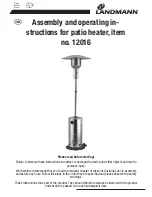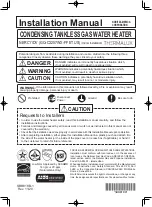
25
HP transfer pump and another hose from the transfer
pump to the fill valve (d) then open this valve.
23. Turn on the transfer pump to fill the system with the
glycol solution and allow to circulate for 15 minutes in
order to flush as much air as possible from the system.
24. Open the air vent at the top of the collector array until
all of the air has been dispersed then close the air vent.
25. Open the vent on the air scoop (j) with a flat head
screwdriver. This will release air that has been captured
by the system during circulation. Cover small outlet
port with a rag as fluid will be ejected after the air is
evacuated.
26. Turn the supply ball valve (b) to 0° (vertical) so that flow
is only allow in the proper direction.
27. With the transfer pump still running close the drain valve
(h) and allow the system to rise to an operating pressure
of 30 psi on the pressure gauge then close the fill valve
and turn off the pump. If the pressure has exceeded
30 psi after the pump is off the slowly open the drain
valve (h) and relieve pressure until the pressure gauge
reads 30 psi. then close the drain valve.
28. Connect the expansion tank and verify the system
pressure. If it has dropped open the fill valve (d) and
turn on the transfer pump. Repeat system pressure
setting in step 27.
29. Remove the fill and drain hoses and close the fill and
drain valves (d, h) with the caps provided. The caps
only serve to protect the valves against dirt. They are
not designed to withstand high system pressures, the
valves must be closed.
Figure 28.
30. Plug in the solar pump station to a 115V outlet and
turn the pump on using the manual mode (see control
operation section).
31. Switch on the pumps using the manual mode.
32. Adjust the solar pump speed using the pump speed
selector on the side of the pump (f). Set the speed to
the lowest level possible to achieve the recommended
system flow rate. See Table 5.
NUMBER OF COLLECTORS
1
2
3
4
COLLECT
OR
SIZE
3.5’ x 7’
0.7
1.4
2.1
2.8
4’ x 8’
1.0
2.0
3.0
4.0
4’ x 10’
1.3
2.6
3.8
5.0
FLOW RATE IN GPM
Table 5.
Adjust the storage tank pump speed using the pump
speed selector on the side of the pump (B). Set the speed
to be one level lower than that of the solar pump.
Cycle the pumps on and off in manual mode to check
whether the starting torque is sufficient with the pump
speed selected. If flow does not start properly a higher
speed may need to be selected. Again check the
installation for leaks and ensure both ball valves are
open completely.
33. Re-insert the temperature gauges and replace the
front cover.
34. Set both pumps on the controller to operate in automatic
mode. See control operation section.
35. After the system has been running for several days
open the air vent at the top of the collector array until
all of the air has been dispersed then close the air vent.
DRAINING
1. Switch off the controller by unplugging the power supply
from the outlet.
2. Open the check valves in the supply and the return ball
valves (a,b) by turning the ball valves to position 45°
with an appropriate wrench
3. Place a temperature-resistant container under the drain
valve (h)
4. Connect a temperature resistant hose to the drain
valve (h) with the discharge end placed in the collection
container
5. Open the drain valve.
6. Open the air vent at the top of the collector array. This
will serve as a vacuum break to aid in draining.
7. Dispose of the solar fluid observing any local codes.
ATTENTION: Upon completion of the pump station
installation and prior to the pump station start-up the
included pump station valve diagram label must be attached
to the pump station piping so that it is in plain view.
Summary of Contents for SRCC OG-100
Page 3: ...3 GENERAL SAFETY...
Page 40: ...40...
















































